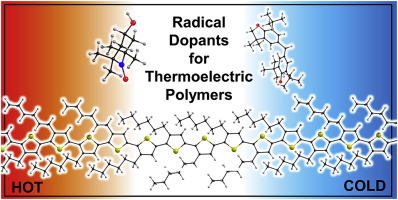Organic Electronics ( IF 3.2 ) Pub Date : 2017-09-17 , DOI: 10.1016/j.orgel.2017.09.029 Edward P. Tomlinson , Sanjoy Mukherjee , Bryan W. Boudouris

|
Organic thermoelectric materials provide a means to reclaim, in part, potentially lost energy through a solid-state process that converts low-value thermal gradients (in the form of heat) to electricity; however, a new avenue towards improving the performance of these emerging thermoelectric materials must be brought to light before their widespread implementation becomes warranted. Here, we develop a blend of open-shell small molecules and closed-shell, conjugated polymers in order to evaluate how the chemical composition of the distinct open-shell, charge-neutral molecular dopants impacts the thermoelectric performance of a common hole-transporting (p-type) polymer semiconductor, poly(3-hexylthiophene) (P3HT). In doing so, we are able to increase the electrical conductivity of the P3HT composite both with and without affecting the oxidation state of the polymer. Specifically, the electrical conductivity of the conjugated polymer increases without changing the oxidation state of the P3HT when the preferentially-oxidized species 4-hydroxy-2,2,6,6-tetramethylpiperidin-1-oxyl (TEMPO) radical is incorporated into the hole-conducting thin film. Moreover, the inclusion of the preferentially-reduced galvinoxyl (GAV) radical also increases the electrical conductivity of the thin film; however, this small molecule dopant changes the oxidation state of the P3HT moiety. The ability to achieve the gains in the electrical conductivity of P3HT with the TEMPO radical in a manner that is independent of its oxidation state was confirmed using optical spectroscopy, cyclic voltammetry, and x-ray diffraction techniques. Importantly, this ability to enhance the electrical conductivity of P3HT in a manner that is independent of the oxidation state of the polymer provides a means to circumvent the oft-observed inverse relationship between the electrical conductivity and thermopower of the semiconducting polymer, and this combined effect allows for an ∼170-fold increase for the TEMPO-containing composites compared to a ∼70-fold increase for the GAV-containing composites. Thus, the described phenomena for charge-neutral radical dopants provides a set of critical design parameters for future polymer thermoelectric materials and composites, and it opens a new pathway towards high-performance organic thermoelectric devices.
中文翻译:

使用自由基掺杂剂提高聚合物热电性能
有机热电材料提供了一种通过固态过程将潜在损失的能量回收的手段,该固态过程将低值的热梯度(以热的形式)转换为电。然而,在保证这些新的热电材料的广泛实施之前,必须提出一条改善这些新的热电材料性能的新途径。在这里,我们开发了开壳小分子和闭壳共轭聚合物的混合物,以评估不同的开壳,电荷中性分子掺杂剂的化学组成如何影响常见空穴传输的热电性能( p型)聚合物半导体,聚(3-己基噻吩)(P3HT)。在这样做,我们能够在不影响聚合物氧化态的情况下提高P3HT复合材料的电导率。具体地,当将优先氧化的物种4-羟基-2,2,6,6-四甲基哌啶-1-氧基(TEMPO)自由基引入孔中时,共轭聚合物的电导率增加而不会改变P3HT的氧化态。导电薄膜。此外,包含优先还原的Galvinoxyl(GAV)自由基也会增加薄膜的电导率;然而,这种小分子掺杂剂改变了P3HT部分的氧化态。使用光谱学,循环伏安法,和X射线衍射技术。重要的是,这种以不依赖于聚合物氧化态的方式增强P3HT的电导率的能力提供了一种手段来规避半导体聚合物的电导率和热功率之间经常观察到的逆关系,以及这种综合作用允许将含TEMPO的复合材料增加约170倍,而将含GAV的复合材料增加约70倍。因此,所描述的电荷中性自由基掺杂剂现象为未来的聚合物热电材料和复合材料提供了一组关键的设计参数,并且为通往高性能有机热电器件开辟了一条新途径。这种以不依赖于聚合物氧化态的方式增强P3HT的电导率的能力,提供了一种手段来规避半导体聚合物的电导率和热功率之间经常观察到的反比关系,并且这种综合作用使得含TEMPO的复合材料增加了约170倍,而含GAV的复合材料增加了约70倍。因此,所描述的电荷中性自由基掺杂剂现象为未来的聚合物热电材料和复合材料提供了一组关键的设计参数,并为通往高性能有机热电器件开辟了一条新途径。这种以不依赖于聚合物氧化态的方式增强P3HT的电导率的能力,提供了一种手段来规避半导体聚合物的电导率和热功率之间经常观察到的反比关系,并且这种综合作用使得含TEMPO的复合材料增加了约170倍,而含GAV的复合材料增加了约70倍。因此,所描述的电荷中性自由基掺杂剂现象为未来的聚合物热电材料和复合材料提供了一组关键的设计参数,并且为通往高性能有机热电器件开辟了一条新途径。



























 京公网安备 11010802027423号
京公网安备 11010802027423号